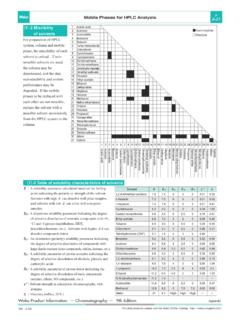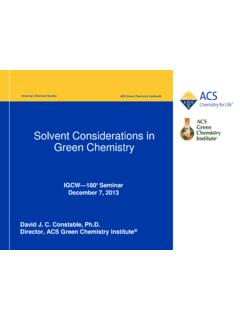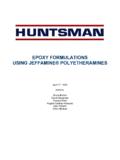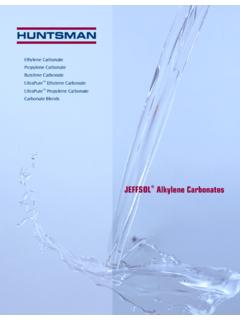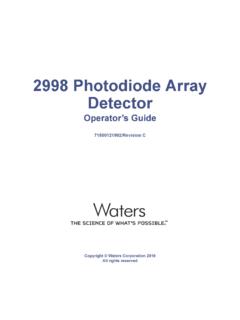Transcription of Column Protection Guide Version 0610 - …
1 Column Protection GuideVersion 0610 Includes: Mobile Phase Limitations Column Storage Tips Column Protection DevicesCoLuMn Protection guiDeTABLe oF ConTenTSINTRODUCTION TO Column CARE AND USAGE 1-4 Selecting the Right Tubing and FittingsColumn InstallationPART I - SILICA-BASED & TWIN TECHNOLOGY columns 4-7 Running ParametersScaling Up/Scaling DownMobile Phase ConsiderationsColumn StorageStationary Phase ConsiderationsColumn Cleaning ProceduresBackpressure and Flow RatesPART II - SFC (SUPERCRITICAL FLUID CHROMATOGRAPHY) 7 Running ParametersCleaning ProcedureEquilibrating ColumnColumn StorageMobile Phase ConsiderationsPART III -AXIA PREPARATIVE columns 8 Running ParametersCleaning ProcedureMobile Phase ConsiderationsColumn StoragePART IV - LUX CHIRAL columns 8-9 Running ParametersExtending Lifetime and ReconditioningMobile Phase ConsiderationsColumn StoragePART V - CHIREX CHIRAL columns 10 Running ParametersMobile Phase ConsiderationsPART VI - BIOSEP-SEC-S columns 10 Running ParametersMobile Phase ConsiderationsCleaning ProcedureColumn StoragePART VII - REZEX POLYMER-BASED columns 11-15 Running ParametersMobile Phase ConsiderationsCleaning ProcedureTable of Specifications and Operating ParametersPART VIII - POLYSEP-GFC-P columns 16 Running ParametersMobile Phase
2 ConsiderationsCleaning ProcedureColumn StoragePART IX - PHENOGEL GPC columns 17, 20-21 SpecificationsSolvent Switching ConsiderationsSample ConsiderationsSolvent Compatibility ChartColumn StorageSOLVENT MISCIBILITY TABLE 18-19 PART X - POLYMERX RP columns 22 SpecificationsCleaning ProcedureRunning ParametersColumn StorageMobile Phase ConsiderationsPART XI - HPLC Column Protection 22-29 AND PERFORMANCE TESTINGP henex Syringe Filters 22-24 Membrane Filters Order List Guide 22-23 Phenex Disposable Centrifugal Filter Units 24 SecurityGuard Guard Cartridge System 25-29 HPLC System Test Kit 30 Column Performance Check Standards 30-33 PART XII - SOLID PHASE EXTRACTION (SPE) 34 PART XIII - HPLC ACCESSORIES 35 PHENOMENEX WARRANTY 36 Column PERFORMANCE RECORD 371inTroDuCTionEvery Phenomenex HPLC Column is a precision product which, though delicate, will provide excellent performance, reproducibility and Column lifetime if cared for properly.
3 The information and recommendations contained in this manual are designed to Guide you in the care and use of your Column , but should not be considered absolute. Please follow the instructions herein to maximize Column performance and lifetime. Should you have any questions, please contact your Phenomenex Technical Representative or local RECEIPT OF THE Column Verify the Column you received is the Column you ordered Check the Column for physical damage which may have occurred during shipping Test the Column immediately to verify performance and quality All columns are shipped in the testing solvent, unless otherwise specifiedEach Phenomenex manufactured HPLC Column is individually packed and tested to ensure high Column quality. Every Column is supplied with its Test Chromatogram and a Specification Sheet which indicates Column serial number and identity, testing conditions and operating warranty period begins upon receipt of the Column .
4 Testing is especially important if the Column is to be placed in storage. Test the Column using the same conditions in the test chromatogram. Use the formulae in Figure 1 to determine Column efficiency and peak performance depends on the entire system, not just the Column . columns are QC tested using optimum conditions to minimize bandspreading from extra Column effects. Most variations from the Phenomenex test data are due to extra- Column effects created by the design of your system ( , injector, flow cell, connecting tubing, etc.). If you have any questions regarding your test results or the Column quality, or if there are signs of damage, CONTACT PHENOMENEX OR YOUR LOCAL DISTRIBUTOR 1 Peak width athalf height (W )is actual width ofpeak at half-heightRetention time for:unretained peakPeak AsymmetryColumn Efficiencypeak 1peak 2tO1R1tR1t R2 AsTangent linesare used in determiningpeak widthat base (W)AWBW W 10 % peakheightA = peak from @ 10 % to droplineB = dropline to peak tail @ 10 %( )Formulae for calculating efficiency and peak asymmetry 2010 Phenomenex, Inc.
5 All rights THe rigHT TuBing AnD FiTTingSThe tubing and fittings on an HPLC system contribute to system dead volume. If not minimized, dead volume can lead to band broadening and peak degradation. Please use the following guideline to keep system dead volume to a minimum and to help ensure optimum Column choice of tubing material is based on its chemical resistivity, application and HPLC system considerations ( flow rate, backpressure, etc). Please refer to Tables 1-3 for DIAMETERT able 1 High Pressure Tubing:1/16 in. OD x in. IDInlet/Outlet Low Pressure Tubing:1/16 in. OD x in. ID1/8 in. OD x in. IDTUBING COMPATIBILITYT able 2 Stainless Steel(Type 316)AVOID high concentrationsof acids or halogenated saltsPEEK (biocompatible)AVOID 100 % THF, chlorinated solvents, high concentrations of acidsTitanium (biocompatible)Compatible with nearly all chemicalsTUBING APPLICATIONST able 3 Tubing ID(Inch) Column IDs (mm)Typical Flow Rates(mL/min) (Fused Silica) - (Stainless Steel) - - - - - - - - - COnSIDeRATIOnS:The shape of the swaged ferrule can differ between manufacturers.
6 For Phenomenex columns , you may use Phenomenex or Valco type IMPORTANT: The seating depth of the nib (Figure 2) for Phenomenex columns is in. Tubing MUST be seated all the way down into the Column end-fitting. Failure to do so will result in having a small mixing chamber at the top or bottom of the Column . This will lead to degraded chromatography. *Polymeric fingertight fittings are easy to use. They come in one piece, require NO tools for attachment and easily conform to the shape of the Column end-fitting. Ferrule32 threads per inchNo. 10 or in. diameterMale Nut1/4 in. OD Standard Analytical (250 x mm ID)1/16 in. ODTubing( in. ID)Female / Inverted (internal) Column end-fitting10-32 Threaded Male nutand FerruleSeating depth of the nib is the critical dimensionPolymericFingertightMale nutFITTINGSAll Phenomenex Column end-fittings are female inverted (internal type) with 10-32 type threading:The end-fitting can fit any 1/16 in.
7 OD tubing (see page 2 for tubing considerations)A 10-32 threaded male nut and ferrule or a polymeric fingertight male nut* is used to swage or tighten the tubing onto the fitting (see Figure 2)Figure 2 Figure 34 Column inSTALLATionIT IS HIGHLY RECOMMENDED THAT YOU READ THIS Guide FOR SPECIFIC Column CONSIDERATIONS BEFORE PROCEEDING WITH THE INSTALLATION (PARTS I-X)Flush HPLC pump and line thoroughly with filtered and degassed mobile phase (without any buffers). Make sure there are no air bubbles in the the Column to the injector corresponding to the direction of the flow label (located on the Column ). Leave the outlet of the Column pump to flow at mL/min (or lowest setting) and increase to normal flow rate over 5 flow when there is a free flow of solvent from the Column outlet, wipe the end and attach to the detectorEquilibrate the Column by passing approximately 10-30 Column volumes of mobile phase at normal flow those columns that can be used under reversed- phase or normal phase conditions ( , -Cn or -nH2), flush with 20-30 Column volumes of IPA or THF as the intermediate solvent when switching from reversed-phase to normal phase modes, or vice i - SiLiCA-BASeD & TWin TeCHnoLogY CoLuMnSrunning PArAMeTerSKeep backpressures below 3500 psi (245 bar)
8 [maximum 5000 psi] unless otherwise specified in Parts I-XAvoid any sudden pressure changes If high backpressure is observed, reverse flush the Column (do not try this on other manufacturers columns )Use a backpressure regulator if you are experiencing out- gassing problems in the detector operating temperature is 60 C for all Phenomenex silica-based reversed phase PHASe ConSiDerATionSUse only HPLC grade solvents and water Use only highest purity chemicals and reagents Filter and degas all mobile phases prior to use Make sure solvents are miscible Trace impurities can dramatically degrade HPLC columns . When changing to a different mobile phase, make sure the solvents and/or buffers are miscible (see Table 11). Using solvents that are immiscible with the solvent in the Column can permanently damage the Column .
9 Salt and buffer precipitation from the mobile phase can permanently damage the Column . Always check sample solubility and if possible use the mobile phase as the diluent (sample solvent).STATionArY PHASe ConSiDerATionSMaintain pH between and * Use presaturator columns and guard columns Avoid aldehydes and ketones with amino columns Silica-based columns are pH sensitive. Low pH (< ) will hydrolyze the bonded phase (strip off the functional groups) and high pH (> ) will dissolve the silica. If the mobile phase pH is near or , use a presaturator Column .*Consult Phenomenex for columns that have extended pH AnD FLoW rATeSTo maximize Column life, flow rates should be adjusted to keep pressures below 3500 psi. Table 4 Particle Internal Typical Flow Typical Pressure(psi) Size m Diameter(mm) Rate(mL/min) 150 mm* 250 mm* 3 | | | 985 | 1640 5 1500 2500 5 750 1250 5 732 1226 5 710 1180 5 750 1250 10 355 590 10 170 280* Column lengthColumns can be operated at any flow rate that is consistent with the backpressure limitations described above.
10 Flow rates should be optimized to provide the best efficiency for your uP/SCALing DoWnAdjusting flow rates for different Column internal diameters is straightforward. To keep the retention times constant, the flow rates and loading capacity must be adjusted according to the Column s internal diameter. Assuming Column length does not change:X = Scale Factor =(radius Column B)2(radius Column A)2 From a mm ID Column some approximate scaling factors are:Table 5 Internal DiameterScaling mm21xHPLC columns running water-free, flammable organic solvents ( , normal phase, chiral, GPC) can generate static electricity and should be properly grounded to avoid a potentially dangerous electrical STorAgeColumn storage conditions affect Column lifetime Never store columns with buffers Flush with 5 Column volumes of mobile phase without buffer to remove any buffers or saltsStorage Conditions for Silica-Based HPLC columns .



